Editor of this issue: Saulius Sužiedėlis
Copyright © 1989 LITUANUS Foundation, Inc.

|
LITUANUS
LITHUANIAN QUARTERLY JOURNAL OF ARTS AND SCIENCES
Volume 35, No.1 - Spring 1989
Editor of this issue: Saulius Sužiedėlis ISSN 0024-5089
Copyright © 1989 LITUANUS Foundation, Inc. |

|
THE MOLOTOV-RIBBENTROP PACT: THE DOCUMENTS
EDITOR'S INTRODUCTION
The day after the signing of the German-Soviet Nonaggression Pact of 23 August 1939 Soviet and German newspapers carried the news and text of the treaty to a stunned Europe. However, from the very beginning there was well-founded suspicion that the Pact contained more than met the eye. According to Richard Maasing, an officer in the Estonian general staff, the Estonian military had realized by 26 August that the Pact divided the Baltic States into German and Soviet spheres of interest and that Estonia had been assigned to the latter. It seems that the Latvian diplomatic service also learned of the contents of the Pact soon after the signing and that rumors about Germany turning over Latvia to Russia proliferated.1 Thus, while the exact contents of the secret protocol of 23 August and the subsequent secret arrangements of 28 September 1939 were unknown to the governments of the Baltic states, and knowledge of the texts was restricted to a small number of German and Soviet officials, the general outline of the agreements on "spheres of influence" was either known or strongly suspected very soon after they were concluded.
Moreover, despite the provisions on strict secrecy, Stalin and Molotov leaked the fact of their secret agreement with the Germans on the spheres of influence during negotiations with Baltic leaders in Moscow as part of the Soviet strategy of pressuring the Baltic governments into accepting the mutual defense pacts with the USSR. This is confirmed by a number of different sources, including the Lithuanian Foreign Minister Juozas Urbšys and Gen. Stasys Raštikis, the Commander of the Lithuanian Armed Forces during the negotiations in Moscow in early October 1939.2 The Soviets informed the Germans of their indiscretion; the leaks to the Baltic ministers irritated the Germans who clumsily attempted to diminish the importance of the secret Pact provisions in their replies to the astonished and perturbed Baltic representatives.3 It is inconceivable that news of the German-Soviet horsetrading concerning the Baltic states did not subsequently come to the attention of the Western powers.
The exact details of the secret territorial provisions of the German-Soviet Nonaggression Pact of 23 August 1939, the German-Soviet Boundaries and Friendship Treaty of 28 September, and the Secret Protocol of 10 January 1941 (concerning the so-called Suwalki Strip), were unknown until the appearance of copies of the secret protocols in the West after the Second World War. It came to the public's attention for the first time as a defense document in the Nuremberg Trials in 1946 and has since been quoted in numerous publications. The description of the secret protocol of 23 August 1939 in the Estonian-language CP daily Rahva Haal of 10 August 1988 (published a week later in Sovetskaya Estoniya) suggested that the original is held by the Foreign Ministry Archive of the German Federal Republic in Bonn. For his part, Valentin Falin, then head of TASS, reiterated at a Moscow press conference that no original of the secret protocol has ever been found.4
In a strictly technical sense, Mr. Falin was right. According to American scholars who worked on the mammoth project of classifying and filming captured German records after the war, the originals of many of the most important documents of the Reich's Foreign Office (Auswaertigen Amt) were, in fact, never found. In 1943, as the archives of the German Foreign Office were being evacuated from Berlin because of the Allied air attacks, Reich Foreign Minister Joachim von Ribbentrop ordered the filming of the most important papers. The work was carried out by Paul Otto Schmidt, the chief interpreter of the Reich Foreign Office. Karl von Loesch, Schmidt's assistant, placed the films into boxes and buried them. Thus, these films survived the destruction of many important Foreign Office records carried out by the Nazis themselves at the close of the war. In late May 1945 Loesch met Lt. Col. R.C. Thomson, chief of the British documents team, and the so-called Loesch films became part of the Captured German Records project. The German-Russian treaties of 23 August 1939 and 28 September 1939, together with their secret protocols, were found in the films of Ribbentrop's working files. (These are contained in part of the series F1-F19 in the German Foreign Office collections).5
Over the years, some East Bloc officials and scholars have either ignored the secret protocols of the German-Soviet treaties, or have presented them as Western forgeries. There are a number of reasons and circumstances that virtually eliminate the possibility that the secret protocols are fakes. As mentioned above, the existence of the protocols was revealed to Baltic statesmen in the autumn of 1939. The Germans, when confronted by indications that territorial arrangements had been worked out between the Reich and the Soviet Union, did not actually deny the existence of such agreements at the time.6 The behavior of both the Soviet and German governments during 1939-1941 indicates a basic understanding of each other's territorial prerogatives in Eastern Europe.
Of course, circumstantial evidence of the existence of an agreement does not address the possibility that understandings different from those described in the secret protocols had been undertaken. However, in addition to forensic testing of an actual original or authentic carbon copy, there are other ways of ascertaining the authenticity of a historic document. As medieval and early modern specialists know, few important historical documents have survived in the original. Often we deal with copies of copies made at a later date; sometimes, documents are excerpted in commentaries, that is, secondary works, and other texts written many years after the fact. In other words, we often learn about texts from references to them in other texts. Naturally, the situation is much better for the nineteenth and twentieth centuries. Yet any overview of references to the Molotov-Ribbentrop Pact contained in captured German correspondence makes the theory of a forgery extremely unlikely if downright impossible.
The number of references, partial quotes from, and allusions to the secret protocols in the available collections of diplomatic documents after the war is quite impressive. The various references can be grouped as follows: (a) the preliminary diplomatic exchanges in July and August 1939 concerning German and Soviet diplomats; (b) the correspondence between 23 August and the end of October 1939; (c) the exchanges of views concerning the territorial changes of summer 1940 ending with Molotov's visit to Berlin in November 1940; (d) the final period before the German attack on the Soviet Union, November 1940-June 1941.7 The evidence for the authenticity of the secret protocols is overwhelming, even if we ignored the memoir literature of the participants themselves.
The way in which the details of the various exchanges of correspondence concerning Poland, the Baltic States and Bessarabia, the territories explicitly named in the German-Soviet correspondence, dovetail with the provisions of the secret protocols, as well as with actual German and Soviet diplomacy, is striking. Any assumption that the secret protocols were a creation would lead to the conclusion that the hundreds of documents which refer to and quote the protocols would also have to be forgeries. That someone could succeed in such a task strains credibility. No forgerer will go out of his way to make a task unnecessarily complicated by increasing the number of factual variables, thus risking exposure. Certainly any creator of these numerous "supporting" documents would have to be aware of the probability that Soviet archives would contain records conflicting with the accounts of events contained in supposedly forged correspondence of the German Foreign Office.
It is important to remember that there is an immense difference between (a) documenting a nonexistent event or communication for propaganda purposes, a well-known disinformation stratagem,8 and (b) structuring a forged document, which distorts an otherwise real event in the more distant past, involving real personalities interacting within a complex bureaucracy. The first type of fabrication is relatively simple and risk-free; it normally requires the creation of only a single document and is a "one-shot" operation. From the forgerer's point of view, the fictitious event cannot be, and need not be, proven or disproven. It can always be affirmed as long as there are those willing to believe the lie.
However, the second type of creation is enormously difficult and, in fact, quite risky for the forger. The danger of discovery is particularly acute if the event in question, such as the negotiation and conclusion of the German-Soviet Nonaggression Pact, is some distance in the past and well-documented by voluminous primary sources. Physical expertise in document creation is of limited help here. Total control over all sources of documentation of the broader historical event in question is the only way to assure success in fabrication. Everything must fit perfectly; every additional fiction necessary to construct the lie considerably increases the number of variables to be taken into account and compounds the risk of detection. The fabricated structure must correspond exactly to the past, both the known and the yet-to-be-discovered. It must fit precisely within the continuum of historical time. The enterprise requires a domination of the past and present as thorough as that envisioned in Orwell's 1984. In real life, particularly in situations where documentation is abundant and scattered among different jurisdictions, this sort of total control over the sources is virtually impossible to achieve.9
The fact is that none of the numerous supporting documents which confirm the existence of the secret protocols has been seriously questioned by competent scholars in the West. There seems little reason to doubt the authenticity of the texts of the secret protocols that partitioned Eastern Europe between Germany and the Soviet Union in 1939. However, even the hint of doubt could finally be laid to rest should the Soviet Union provide access to its archives on the 1939-1941 period for credible and independent scholars. There would be no lack of expert help in finding the important documents assuming they are still extant. As one of Lithuania's leading and most popular poets, Justinas Marcinkevičius, told the 23 August 1988 demonstration in Vilnius on the anniversary of the Molotov-Ribbentrop pact:
And so, these days Moscow's scholars have once again announced in the press that they still cannot, are unable, to find these (secret) protocols in Soviet archives. This is a joke, nothing else. It is entirely clear that Moscow does not locate that which it does not want to find, that which is unnecessary to find. One can search, but one doesn't need to find. I say, perhaps, Baltic historians and archivists could help them (in Moscow). This would truly constitute unselfish fraternal assistance for the sake of historical truth.10
Note: Some frames of the microfilm copies of the German-Soviet pacts housed in the National Archives in Washington, D.C. are not in the best condition. The German and Russian-language facsimiles of the German-Soviet Nonaggression Pact of 23 August 1939 and the Secret Supplementary Protocol presented here were published in Jan Szembek, Diariusz i teki (London: Polish Research Centre, 1972), iv, 752-760. The other texts are from the National Archives, T-120, Records of the German Foreign Office. The English translations are from Raymond James Sontag and James Stuart Beddie, eds., Nazi-Soviet Relations: Documents from the German Foreign Office (Washington: Department of State, 1948). Another useful collection of documents translated into English is Bronis J. Kasias, ed., The USSR-German Aggression against Lithuania (New York: Robert Speller and Sons, 1973).
Pages 1-5: The German text of the Treaty of Nonaggression Between Germany and the USSR, 23 August 1939 and the Supplementary Secret Protocol, 23 August 1939, signed by Joachim von Ribbentrop and Vyacheslav Molotov.
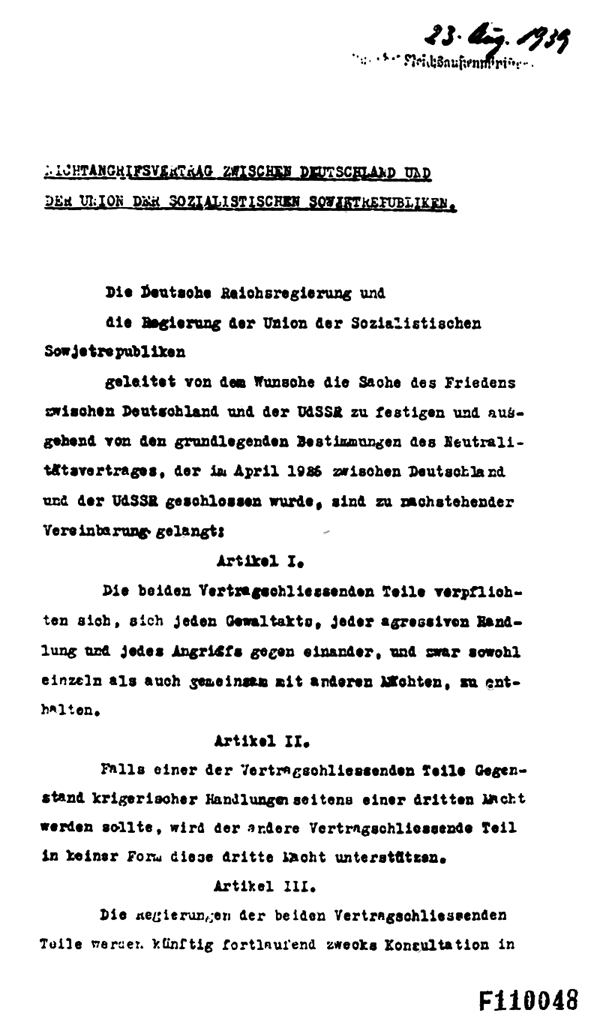
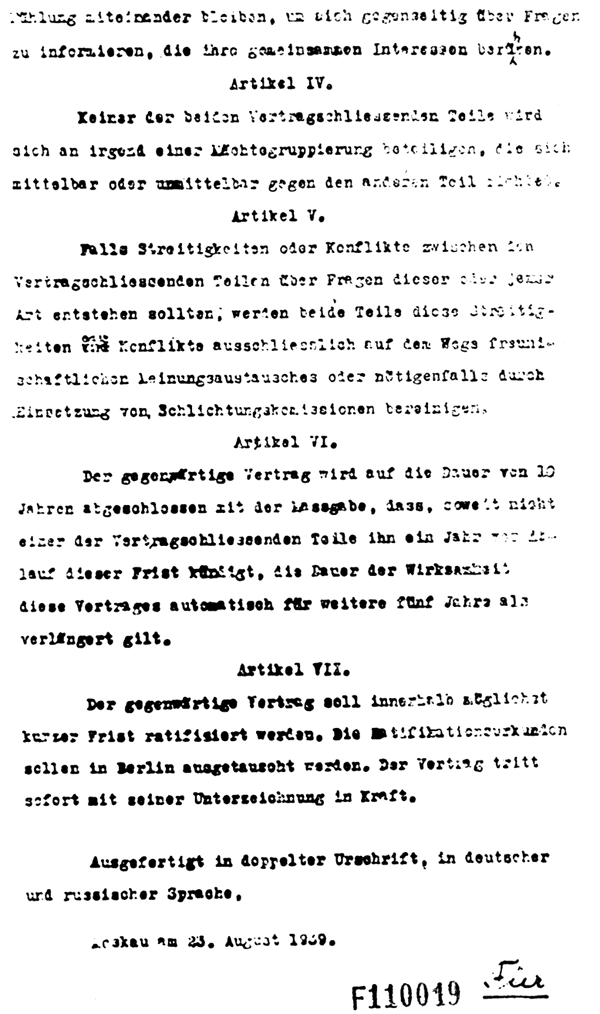
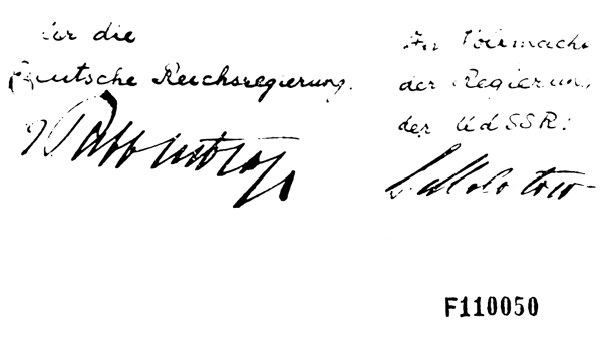
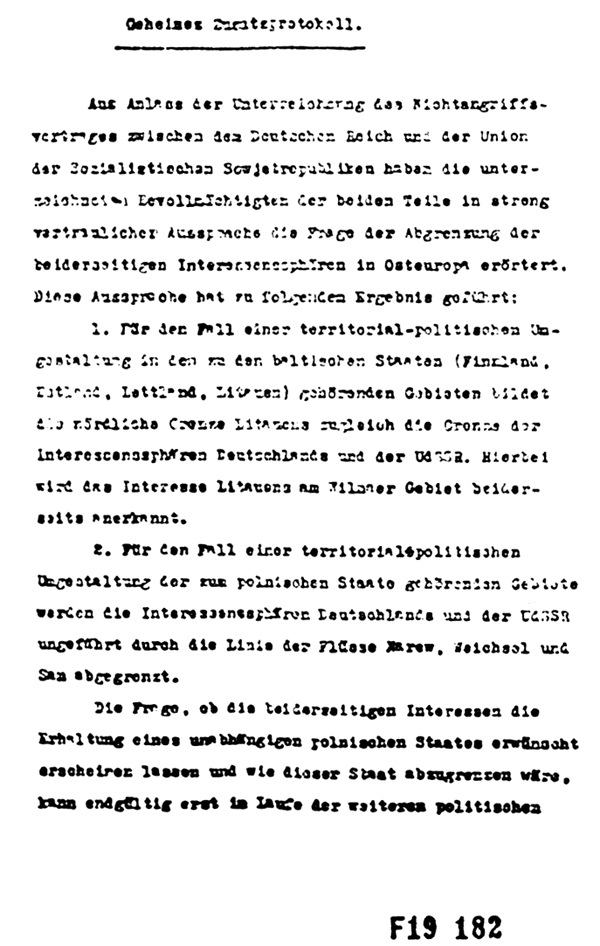
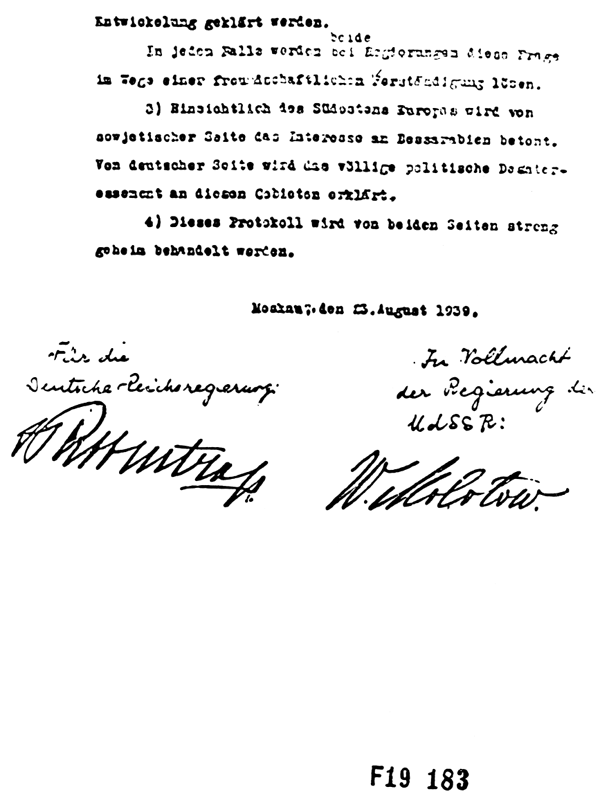
Pages 1-3: The Russian text of the Treaty of Nonaggression Between Germany and the Soviet Union, 23 August 1939 and the Supplementary Secret Protocol, 23 August 1939, signed by Joachim von Ribbentrop and Vyacheslav Molotov.
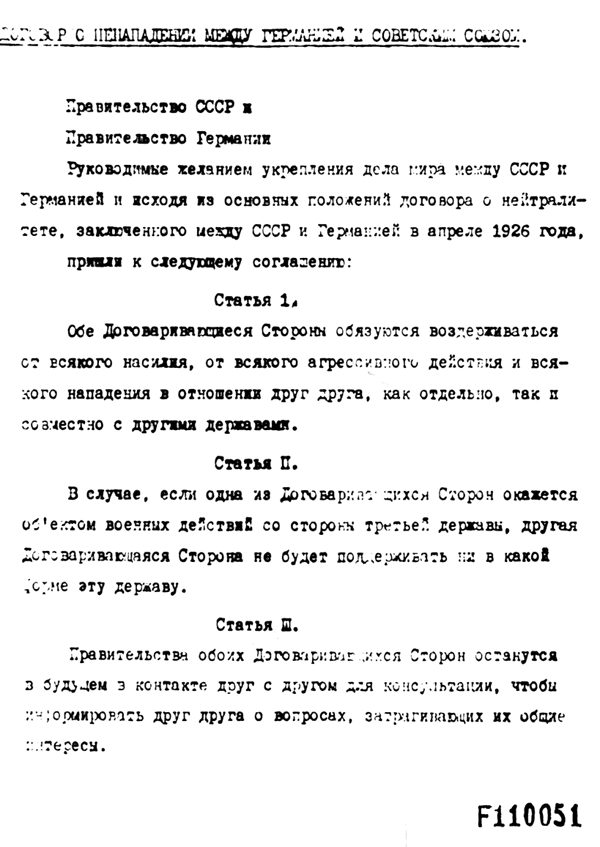
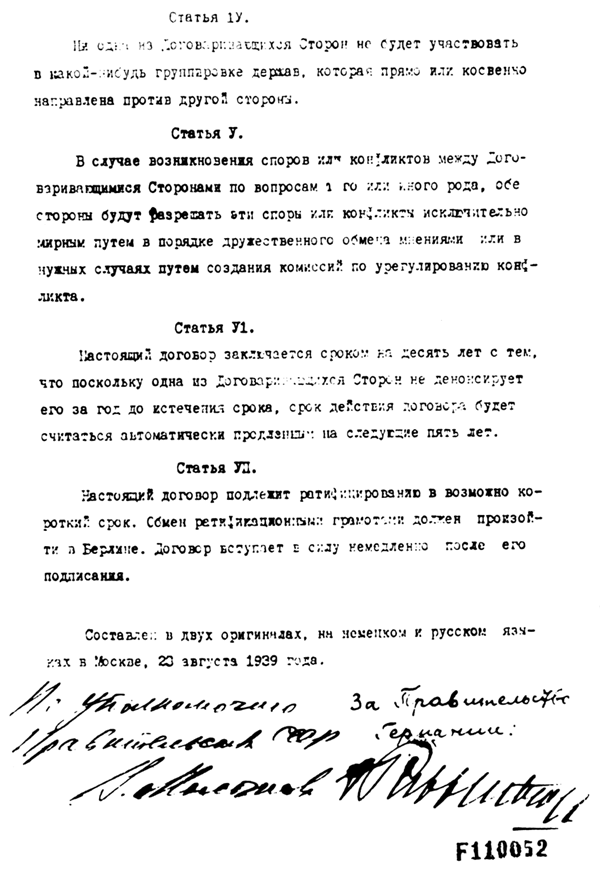
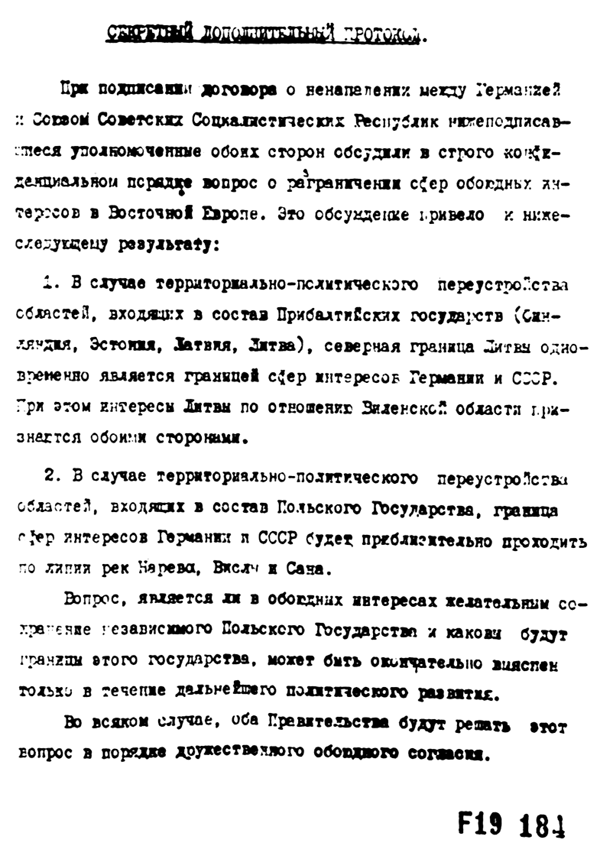
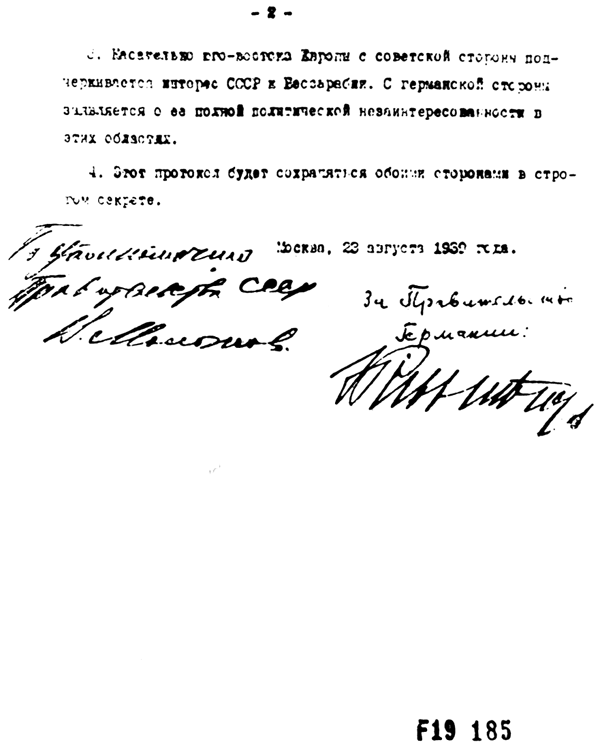
Source: Jan Szembek, Diariusz i Teki (London: Polish Research Centre, 1972), IV, 752-760 as provided by the British Foreign and Commonwealth Office Library.
THE DOCUMENTS IN TRANSLATION:
TEXTS OF TREATIES AND CORRESPONDENCE 1939-1941
- Treaty of Nonaggression Between Germany and the Union of Soviet Socialist Republics and the Secret Additional Protocol, 23 August 1939.
- Secret Additional Protocol of 28 September 1939 Amending the Secret Agreement of 23 August 1939.
- German-Soviet Boundary and Friendship Treaty of 28 September 1939; Confidential Protocols Concerning Repatriation and Political Subjugation of Poland; Declaration of the German Reich and the Government of the USSR.
- German-Soviet Protocol of 10 January 1941 Concerning Transfer of the Rights to the Suwalki Strip to the USSR.
GERMAN CORRESPONDENCE ON THE PACT, OCTOBER 1939
- The German Foreign Minister Ribbentrop, to the German Ambassador in Moscow, Schulenberg.
- The German Minister in Kaunas Informed of the Secret Protocol; Zechlin Reports on Lithuanian Reaction.
- Ribbentrop Tells German Envoys in the Baltic About the Secret Protocol.
EDITOR'S NOTE: The English-language translations of the German and Russian documents presented are taken from the following sources with only slight adaptations: Raymond Janes Sontag and James Stuart Beddie, ed. Nazi-Soviet Relations: Documents from the Archives of the German Foreign Office (Washington, D.C.: Dept. of State, 1948), 76-78, 105-107; Paul R. Sweet et. al, ed., Documents on German Foreign Policy 1918-1945: From the Archives of the German Foreign Ministry. (Washington: Dept. of State, 1949-1964), Series D, Vol. VIII (1954), 166; Vol. XI (1960), 1068. The three documents of October 1939 are from the German Foreign Office files, from Documents, Vol. VIII, 214-215, 238. These and other documents are conveniently assembled in Bronis J. Kasias, ed. The USSR-German Aggression Against Lithuania (New York: Robert Speller and Sons, 1973).
Treaty of Nonaggression Between Germany and the Union of Soviet Socialist Republics
The Government of the German Reich and the Government of the Union of Soviet Socialist Republics desirous of strengthening the cause of peace between Germany and the U.S.S.R., and proceeding from the fundamental provisions of the Neutrality Agreement concluded in April 1926 between Germany and the U.S.S.R., have reached the following agreement:
Article I
Both High Contracting Parties obligate themselves to desist from any act of violence, any aggressive action, and any attack on each other either individually or jointly with other powers.
Article II
Should one of the High Contracting Parties become the object of belligerent action by a third power, the other High Contracting Party shall in no manner lend its support to this third power.
Article III
The Governments of the two High Contracting Parties shall in the future maintain continual contact with one another for the purpose of consultation in order to exchange information on problems affecting their common interests.
Article IV
Neither of the two High Contracting Parties shall participate in any grouping of powers whatsoever that is directly or indirectly aimed at the other party.
Article V
Should disputes or conflicts arise between the High Contracting Parties over problems of one kind or another, both parties shall settle these disputes or conflicts exclusively through friendly exchange of opinion or, if necessary, through the establishment of arbitration commissions.
Article VI
The present treaty is concluded for a period of ten years, with the proviso that, in so far as one of the High Contracting Parties does not denounce it one year prior to the expiration of this period, the validity of this treaty shall automatically be extended for another five years.
Article VII
The present treaty shall be ratified within the shortest possible time. The ratifications shall be exchanged in Berlin. The agreement shall enter into force as soon as it is signed.
Done in duplicate, in the German and Russian languages.
Moscow, August 23, 1939.
|
For the Government of the German Reich: |
With full power of the Government of the U.S.S.R.: |
| v. Ribbentrop | V. Molotov |
Secret Additional Protocol
On the occasion of the signature of the Nonaggression Pact between the German Reich and the Union of Soviet Socialist Republics the undersigned plenipotentiaries of each of the two parties discussed in strictly confidential conversations the question of the boundary of their respective spheres of influence in Eastern Europe. These conversations led to the following conclusions:
1. In the event of a territorial and political rearrangement in the areas belonging to the Baltic States (Finland, Estonia, Latvia, Lithuania), the northern boundary of Lithuania shall represent the boundary of the spheres of influence of Germany and the U.S.S.R. In this connection the interest of Lithuania in the Vilnius area is recognized by each party.
2. In the event of a territorial and political rearrangement of the areas belonging to the Polish state the spheres of influence of Germany and the U.S.S.R. shall be bounded approximately by the line of the rivers Narew, Vistula, and San.
The question of whether the interests of both parties make desirable the maintenance of an independent Polish state and how such a state should be bounded can only be definitely determined in the course of further political developments.
In any event both Governments will resolve this question by means of a friendly agreement.
3. With regard to Southeastern Europe attention is called by the Soviet side to its interest in Bessarabia. The German side declares its complete political disinterestedness in the areas.
4. This protocol shall be treated by both parties as strictly secret.
Moscow, August 23, 1939.
|
For the Government of the German Reich: |
Plenipotentiary of the Government of the U.S.S.R.: |
| v. Ribbentrop | V. Molotov |
Secret Additional Protocol of 28 September 1939
The undersigned plenipotentiaries declare the agreement of the Government of the German Reich and the Government of the U.S.S.R. upon the following:
The Secret Additional Protocol signed on August 23,1939, shall be amended in item 1 to the effect that the territory of the Lithuanian state falls to the sphere of influence of the U.S.S.R., while, on the other hand, the province of Lublin and parts of the province of Warsaw fall to the sphere of influence of Germany (cf. the map attached to the Boundary and Friendship Treaty signed today). As soon as the Government of the U.S.S.R. shall take special measures on Lithuanian territory to protect its interests, the present German-Lithuanian border, for the purpose of a natural and simple boundary delineation, shall be rectified in such a way that the Lithuanian territory situated to the southwest of the line marked on the attached map falls to Germany.
Further it is declared that the economic agreements now in force between Germany and Lithuania shall not be affected by the measures of the Soviet Union referred to above.
Moscow, September 28, 1939
|
For the Government of the German Reich: |
By authority of the Government of the U.S.S.R.: |
| v. Ribbentrop | V. Molotov |
German-Soviet Boundary and Friendship Treaty of September 28, 1939
The Government of the German Reich and the Government of the U.S.S.R. consider it exclusively their task, after the collapse of the former Polish state, to re-establish peace and order in these territories and to assure to the peoples living there a peaceful life in keeping with their national character. To this end, they have agreed upon the following:
Article I
The Government of the German Reich and the Government of the U.S.S.R. determine as the boundary of the respective national interests in the territory of the former Polish state the line marked on the attached map, which shall be described in more detail in a supplementary protocol.
Article II
Both parties recognize the boundary of the respective national interests established in Article 1 as definitive and shall reject any interference of third powers in this settlement.
Article III
The necessary reorganization of public administration will be effected in the areas west of the line specified in 1 by the Government of the German Reich, in the areas east of the line by the Government of the U.S.S.R.
Article IV
The Government of the German Reich and the Government the U.S.S.R. regard this settlement as a firm foundation for a progressive development of the friendly relations between their peoples.
Article V
This treaty shall be ratified and the ratifications shall be exchanged in Berlin as soon as possible. The treaty becomes effective upon signature.
Done in duplicate, in the German and Russian languages.
Moscow, September 28, 1939
|
For the Government of the German Reich: |
By authority of the Government of the U.S.S.R.: |
| J. Ribbentrop | V. Molotov |
Confidential Protocol
The Government of the U.S.S.R. shall place no obstacles in the way of Reich nationals and other persons of German descent residing in the territories under its jurisdiction, if they desire to migrate to Germany or to the territories under German jurisdiction. It agrees that such removals shall be carried out by agents of the Government of the Reich in cooperation with the competent local authorities and that the property rights of the emigrants shall be protected.
A corresponding obligation is assumed by the Government of the German Reich in respect to the persons of Ukrainian or Belorussian descent residing in the territories under its jurisdiction.
Moscow, September 28, 1939
|
For the Government of the German Reich: |
By authority of the Government of the U.S.S.R.: |
| J. Ribbentrop | V. Molotov |
Secret Additional Protocol
The undersigned plenipotentiaries, on concluding the German-Russian Boundary and Friendship Treaty, have declared their agreement upon the following:
Both parties will tolerate no Polish agitation in their territories which affects the territories of the other party. They will suppress in their territories all beginnings of such agitation and inform each other concerning suitable measures for this purpose.
Moscow, September 28, 1939
|
For the Government of the German Reich: |
By the Authority of the Government of the U.S.S.R.: |
| J. Ribbentrop | V. Molotov |
German-Soviet Secret Protocol
The German Ambassador, Count von der Schulenburg, Plenipotentiary of the Government of the German Reich, on the one hand, and the Chairman of the Council of People's Commissars of the U.S.S.R., V.M. Molotov, Plenipotentiary of the Government of the U.S.S.R., on the other hand, have agreed upon the following:
1. The Government of the German Reich renounces its claim to the strip of Lithuanian territory which is mentioned in the Secret Additional Protocol of September 28, 1939, and which has been marked on the map attached to this Protocol;
2. The Government of the Union of Soviet Socialist Republics is prepared to compensate the Government of the German Reich for the territory mentioned in Point 1 of this Protocol by paying 7,500,000 gold dollars or 31,500,000 million reichsmarks to Germany.
The amount of 31,5 million Reichsmarks will be paid by the Government of the U.S.S.R. in the following manner: one-eight, that is, 3,937,500 Reichsmarks, in nonferrous metal deliveries within three months after the signing of this Protocol, the remaining seven-eights, or 27,562,500 Reichsmarks in gold by deduction from the German gold payments which Germany is to make by February 11, 1941, in accordance with the correspondence exchanged between the Chairman of the German Economic Delegation, Dr. Schnurre, and the People's Commissar for Foreign Trade of the U.S.S.R., A.I. Mikoyan, in connection with the "Agreement of January 10,1941, concerning reciprocal deliveries in the second treaty period on the basis of the Economic Agreement between the German Reich and the Union of Soviet Socialist Republics of February 11, 1940."
3. This Protocol has been executed in two originals in the German language and two originals in the Russian language and shall become effective immediately upon signature.
Moscow, January 10, 1941.
|
For the Government of the German Reich: |
By authority of the Government of the U.S.S.R.: |
|
Schulenburg (Seal) |
V. Molotov (Seal) |
The German Foreign Minister, Ribbentrop, to the German Ambassador in Moscow, Schulenburg
Telegram
Very urgent
Strictly secret
No. 497 of October 4
Berlin, October 5, 19393:43 a.m.
Received Moscow, October 5, 193911:55 a.m.
Referring to today's telephonic communication from the Ambassador.
The Legation in Kaunas is being instructed as follows:
1) Solely for your personal information, I am apprising you of the following: At the time of the signing of the German-Russian Nonagression Pact on August 23, a strictly secret delimitation of the respective spheres of influence in Eastern Europe was also undertaken. In accordance therewith, Lithuania was to belong to the German sphere of influence, while in the territory of the former Polish state, the so-called four-river line, Pissa-Narew-Vistula-San, was to constitute the border. Even then I demanded that the district of Vilnius go to Lithuania, to which the Soviet Government consented. At the negotiations concerning the Boundary and Friendship Treaty on September 28, the settlement was amended to the extent that Lithuania, including the Vilnius area, was included in the Russian sphere of influence, for which in turn, in the Polish area, the province of Lublin and large portions of the province of Warsaw, including the pocket of territory of Suwalki, fell within the German sphere of influence. Since, by the inclusion of the Suwalki tract in the German sphere of influence a difficulty in drawing the border line resulted, we agreed that in case the Soviets should take special measures in Lithuania, a small strip of territory in the southwest of Lithuania, accurately marked on the map, should fall to Germany.
2) Today Count von der Schulenburg reports that Molotov, contrary to our own intentions, notified the Lithuanian Foreign Minister last night of the confidential arrangement. Please now, on your part, inform the Lithuanian Government, orally and in strict confidence, of the matter, as follows:
As early as at the signing of the German-Soviet Nonagression Pact of August 23, in order to avoid complications in Eastern Europe, conversations were held between ourselves and the Soviet Government concerning the delimitation of German and Soviet spheres of influence. In these conversations I had recommended restoring the Vilnius district to Lithuania, to which the Soviet Government gave me its consent. In the negotiations concerning the Boundary and Friendship Treaty of September 28, as is apparent from the German-Soviet boundary demarcation which is published, the pocket of territory of Suwalki jutting out between Germany and Lithuania had fallen to Germany. As this created an intricate and impractical boundary, I had reserved for Germany a border correction in this area, whereby a small strip of Lithuanian territory would fall to Germany. The award of Vilnius to Lithuania was maintained in these negotiations also. You are now authorized to make it known to the Lithuanian Government that the Reich Government does not consider the question of this border revision timely at this moment. We make the proviso, however, that the Lithuanian Government treat this matter as strictly confidential. End of instruction for Kaunas.
I request you to inform Mr. Molotov of our communication to the Lithuanian Government. Further, please request of him, as already indicated in the preceding telegram, that the border strip of Lithuanian territory involved be left free in the event of a possible posting of Soviet trrops in Lithuania and also that it be left to Germany to determine the date of the implementing of the agreement concerning the cession to Germany of the territory involved. Both of these points at issue should be set forth in a secret exchange of letters between yourself and Molotov.
Ribbentrop
The German Minister in Kaunas, Zechlin, to the German Foreign Office
Telegram
Most urgent
No. 175 of October 5
Kaunas, October 5, (1939)7:55 p.m.
Received October 510:30 p.m.
With reference to telegram No. 252 of October 5 (4)
[Deputy Prime Minister Kazys] Bizauskas sent for me today even before I could ask for an appointment with the Foreign Minister as instructed in telegram No. 252; he first made excuses for Mr. Urbšys, who was completely occupied today with continuous discussions in the Cabinet and therefore unfortunately could not speak with me himself. He then informed me that Molotov had told Urbšys that Germany had laid claim to a strip of Lithuanian territory, the limits of which included the city and district of Naumiestis and continued on past the vicinity of Mariampolė. This had made a deep and painful impression on Lithuania, and Urbšys had flown back to Kaunas partly because of this information, which he had not wished to transmit by telephone.
The Lithuanian Government has instructed Škirpa to make inquiries in Berlin.
I told him that in the Moscow discussions on the delimitation of the German and Soviet spheres of interest, the Reich Foreign Minister had advocated giving the Vilnius area to Lithuania and had also obtained the Soviet Government's agreement in the matter. While Lithuania had the prospect of such a great increase in territory a difficult and impracticable boundary in the vicinity of the Suwalki tip had come into existence because of the German-Soviet border division. Therefore the idea of a small border rectification at the German-Lithuanian frontier had also emerged in the course of these negotiations; but I could inform him that the German Government did not consider the question pressing. Bizauskas received this information with visible relief and asked me to transmit the thanks of the Lithuanian Government on his score to the Reich Government. Furthermore he asked on his part that the matter be kept strictly secret, which I promised him.
I might add that since the fixing of the German-Soviet frontier became known, political quarters here have had great hopes of obtaining the Suwalki tip from Germany.
Zechlin
The German Foreign Minister, Ribbentrop, to the German Ministers in Tallinn, Riga and Helsinki
Telegram
Most Urgent
(1) To Talinn, N. 257
(2) To Riga, No. 328
(3) To Helskin, No. 318
Berlin, October 7, 1939
Exclusively for the Minister personally.
Supplementing our telegrams No. 241 to (1), No. 303 to (2) and No. 305 to (3), I am communicating the following to you in strict secrecy and for your personal information only:
During the Moscow negotiations with the Soviet Government the question of delimiting the spheres of interest of both countries in Eastern Europe was discussed in strict confidence, not only with reference to the area of the former Polish state, but also with reference to the countries of Lithuania, Latvia, Estonia, and Finland. At the same time the delimitation of the spheres of interest was agreed upon for the eventuality of a territorial and political reorganization in these areas. The borderline fixed for this purpose for the territory of the former Polish state is the line designated in article 1 of the German-Soviet Boundary and Friendship Treaty of September 28 and publicly announced. Otherwise, the line is identical with the German-Lithuanian frontier. Thus it follows that Lithuania, Latvia, Estonia, and Finland do not belong to the German sphere of interest in the sense indicated above.
You are requested to refrain, as heretofore, from any explanations on this subject.
The Foreign Minister
1 See the article "The Molotov-Ribbentrop Pact and the Baltic States" in this issue, fn. 66.
2 Juozas Urbšys, Lietuva ir Tarybų Sąjunga lemtingaisiais Lietuvai 1939-1940 metais (Vilnius:
Mintis, 1988); Stasys Raštikis, Kovose dėl Lietuvos (Brooklyn, N.Y.:
Karys, 1956), l, 609-610.
3 Schulenburg to German Foreign Office, 5 October 1939, Nazi-Soviet Relations, 114 and Ribbentrop to Schulenburg, 5 October 1939, ibid., 115-116.
4 New York Times, 17 August 1988; Sovetskaya Estohiya, 17 August 1988.
5 The important German-Soviet pacts of 1939-1941 are contained in National Archives, T-120. See George O. Kent, "The German Foreign Ministry Archives," in Robert Wolfe, ed. Captured German and Other Related Records (Athens: Ohio Univ. Press, 1974), 119-130. See Paul Sweet's letter to the
New York Times, 2 September 1988.
6 Ribbentrop to Schulenburg, 5 October 1939, Nazi-Soviet Relations, 116.
7 Dozens of such references are contained in Nazi-Soviet Relations, as well as the more massive publications in Paul R. Sweet et al., ed.,
Akten zur deutschen auswaertigen Politik, 1918-1945, Series D. vols. 7-9 (Baden-Baden: Imprimier
Nationale, 1951-2), as well as the English-language Documents on German Foreign Policy, 1918-1945, Series D: Vols. 7-9 (Washington: U.S. Government Printing Office), also edited by Paul Sweet.
8 Examples here are the so-called Protocols of the Elders of Zion or the KGB active measures against NATO and the U.S.. State Department in the 1960s and 1970s.
9 The importance of controlling all variables in a fabrication is revealed by the famous case of the defendant
E.S. Goltsman during the Stalinist show trials in Moscow in the 1930s. Goltsman claimed he conspired with Trotsky's son in the Bristol Hotel in Copenhagen in 1932. The hotel, it turned out, had been demolished in 1917. See Roy A.
Medvedev, Let History Judge (New York: Vintage, 1971), 250.
10 As quoted in Atgimimas, 16 September 1988, 8.